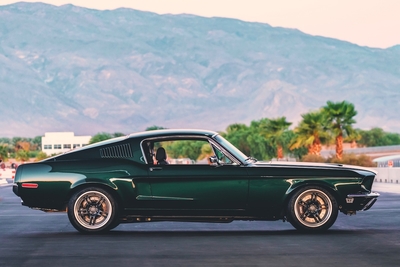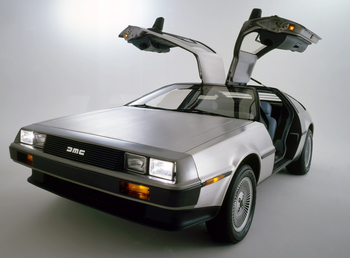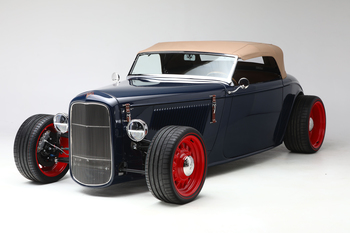SEMA News—August 2020
LEGISLATIVE AND TECHNICAL AFFAIRS
Replica Cars—
It’s Back to the Future Time
 Revology’s ’68 Mustang GT 2+2 Fastback R Spec. |
The industry’s reaction in 2015 to enactment of the replica car law could be described in two words: giddy enthusiasm. Companies would soon be able to produce and sell new turnkey vehicles that resembled classic vehicles produced at least 25 years ago. Passage of the law had taken just four years following the bill’s introduction—a relatively short period on Capitol Hill—but who knew that it would take five years of lobbying and a lawsuit before companies could begin selling replica cars?
The wait for the National Highway Traffic Safety Administration to issue a regulation to implement the law has been agonizingly slow. A draft rule wasn’t issued until this past January. It is expected to be finalized by November 2020, if not sooner, allowing companies to register with the agency and begin sales. In anticipation of that action, this article provides an overview of the law and why it was needed.
In the ’60s, the National Highway Traffic Safety Administration created a system for regulating companies that mass-produced millions of automobiles. However, the agency never created a second system for businesses that made a small number of vehicles each year—whether that number was one, 50 or 1,000. While other countries developed regulations that recognized the unique challenge of creating a custom-made vehicle, the United States did not.
 The Superformance MKIII-R, a modern take on the iconic Cobra. |
Despite the regulatory roadblocks, there has been a niche market for companies to sell unique vehicles. It is called the “kit-car” market, whereby a manufacturer sells an incomplete automobile, frequently pre-assembled, and a buyer installs the engine/transmission, thereby transforming the parts into a motor vehicle. While states usually regulate hobbyist-built kit cars by the model year they resemble, the National Highway Traffic Safety Administration viewed a manufacturer-completed replica car to be a current model-year vehicle, making it nearly impossible for a company to offer a turnkey car.
SEMA helped craft legislation introduced in Congress in 2011 to create a separate regulatory system for low-volume vehicle manufacturers. The bill adopted the kit-car approach for regulatory oversight whereby the completed automobiles are subject to all federal safety standards for equipment (tires, lighting, glass, etc.) but not vehicle-based standards. Low-volume vehicle manufacturers (under 5,000 worldwide production) may take advantage of the law and sell up to 325 turnkey replica cars a year in the United States.
Popular kit car models in recent years have been ’30s-era hot rods and ’60s-era Cobras. However, there are no restrictions for the type of replica cars to be sold beyond the 25-year limitation. Further, the law applies to the appearance of the vehicle, so the cars may incorporate new platforms and high-performance equipment under the hood.
ICON’s unique FJ40 is ready for the open road. |
The vehicles will also be clean cars that meet current model-year emissions standards. That will be achieved through the installation of engine packages approved by the U.S. Environmental Protection Agency (EPA) or by the California Air Resources Board (CARB) for vehicles produced or sold in California. SEMA and industry representatives worked with both agencies to develop guidelines and regulations governing the engine packages. Most of the engine packages will be supplied by the larger vehicle and original-equipment manufacturers.
While SEMA and the industry celebrate the approaching start to the replica car program, the road to success has been unexpectedly long and tortuous. Eager customers began placing orders in 2016, as companies geared up for production. Some companies built new facilities and placed orders with part suppliers. Instead of sales, however, the lengthy delay imposed significant economic pain. SEMA sued the National Highway Traffic Safety Administration in 2019 for failure to issue a regulation in a timely fashion. The suit had its intended effect, helping spur issuance of the proposed rule and soon-to-be-released final rule.
When the replica car law finally takes effect, SEMA will welcome the opportunity for customers to buy their dream cars and for low-volume manufacturers to rejoice in making those dreams come true.
 The new and timeless DeLorean. |
Low-Volume Motor Vehicle Manufacturers Act” Questions and Answers
Why Is This Law Necessary? Until 2015, all motor vehicle manufacturers were treated the same, regardless of whether a company produced one car or one million. The law directs NHTSA to create a simplified regulatory program that takes into account the unique differences between a company that mass-produces thousands of cars and one that handcrafts a limited number.
What Is a Low-Volume Manufacturer? The law states that a low-volume manufacturer is a company whose annual worldwide production (including by a parent or subsidiary of the manufacturer) is not more than 5,000 motor vehicles each year. These companies will each be able to sell up to 325 “replica” cars annually in the United States.
How Does the Law Define a Replica Vehicle? A replica vehicle resembles the body of another motor vehicle produced at least 25 years ago. The vehicle is produced under a license agreement from the original manufacturer, its successor/assignee, or the current owner of the replicated vehicle’s intellectual property rights. In some instances, the replica car manufacturer may be the current owner (for example, when the original manufacturer no longer exists or the replica car has a distinguishably different appearance and brand name).
How Are Replica Cars Regulated by NHTSA? Replica vehicles are subject to NHTSA’s equipment standards, including lighting, brake hoses, glass and tires. However, the automobiles are exempt from safety standards that apply to motor vehicles (roof crush, side impact, bumper standard, etc.). The exemption recognizes that it is impractical to apply current model-year standards to vehicles designed decades ago or to crash test such vehicles when only a few are being produced.
 Factory Five’s all-new second-generation ’33 Hot Rod with the optional ’32 Deluxe nose. |
How Are Replica Cars Regulated by the EPA and CARB? Replica cars will meet current model-year emissions standards. The engine package must be approved by the EPA and, if produced or sold in California, by CARB. SEMA and the replica car industry worked with both agencies to develop an EPA guidance document and CARB regulation for recognizing compliant engine packages.
When Will the Program Begin? The program has been on hold while NHTSA drafted a regulation. NHTSA issued a proposed rule in January 2020 and is expected to finalize the rule by the fall of 2020. The rule becomes effective upon publication, which means companies can then file registration applications to be reviewed by NHTSA within 90 days, allowing sales to commence. Companies are also required to register and file annual reports with the EPA and CARB.
How Will This Law Impact Kit-Car Consumers? Hobbyists will still have the freedom to assemble their own vehicles from kits if they prefer, including modern-era cars. The law expands the market of who can purchase a replica car to include those who don’t have the time or skills to complete a kit car. In short, this law means more business opportunities for the industry and more choices for consumers.
Will I Be Able to Title/Register the Car? SEMA has worked with many states to establish specific categories for titling, registering and regulating “kit cars” (e.g., street rods and customs, including replicas and specialty constructed vehicles), which will also apply to turnkey replicas. For more information on the laws in your state, visit the “Titling & Registration” page on the SEMA Action Network’s website at www.semasan.com.
Where Can I Find More Information? Visit www.sema.org/replica.






